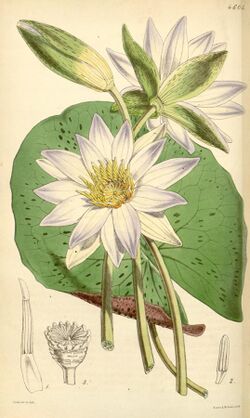Biology:Nymphaea subg. Brachyceras
From HandWiki
Short description: Subgenus of flowering plants
| Nymphaea subg. Brachyceras | |
|---|---|

| |
| Botanical illustration of Nymphaea elegans | |
| Scientific classification | |
| Kingdom: | Plantae |
| Clade: | Tracheophytes |
| Clade: | Angiosperms |
| Order: | Nymphaeales |
| Family: | Nymphaeaceae |
| Genus: | Nymphaea |
| Subgenus: | Nymphaea subg. Brachyceras (Casp) Conard[1] |
| Type species | |
| Nymphaea stellata Willd.[2][3] | |
| Species | |
|
See here | |
Nymphaea subg. Brachyceras is a subgenus of the genus Nymphaea.[4][5]
Description
Vegetative characteristics
The rhizome is ovate to oblong.[6] The rhizome is not stoloniferous.[3]
Generative characteristics
The flowers are diurnal.[5] Sepals are persistent on the fruit.[6]
Taxonomy
Publication
It was published as Nymphaea subsect. Brachyceras Casp. by Robert Caspary in 1866. Later, it was elevated to the subgenus Nymphaea subg. Brachyceras (Casp.) Conard published by Henry Shoemaker Conard in 1905.[1][2][7]
Type species
The type species is Nymphaea stellata Willd.[2][3]
Species
- Nymphaea abhayana A.Chowdhury & M.Chowdhury
- Nymphaea ampla (Salisb.) DC.
- Nymphaea × daubenyana W.T.Baxter ex Daubeny
- Nymphaea dimorpha I.M.Turner
- Nymphaea divaricata Hutch.
- Nymphaea elegans Hook.
- Nymphaea gracilis Zucc.
- Nymphaea guineensis Schumach. & Thonn.
- Nymphaea heudelotii Planch.
- Nymphaea maculata Schumach. & Thonn.
- Nymphaea manipurensis Asharani & Biseshwori
- Nymphaea micrantha Guill. & Perr.
- Nymphaea nouchali Burm.f.
- Nymphaea pulchella DC.
- Nymphaea siamensis Puripany.
- Nymphaea stuhlmannii (Engl.) Schweinf. & Gilg
- Nymphaea sulphurea Gilg
- Nymphaea thermarum Eb.Fisch.
Distribution
Nymphaea subg. Brachyceras has a pantropical distribution.[7][5][4]
References
- ↑ 1.0 1.1 Nymphaea subgen. Brachyceras | International Plant Names Index. (n.d.). Retrieved January 23, 2024, from https://www.ipni.org/n/77303968-1
- ↑ 2.0 2.1 2.2 Nymphaea subsect. Brachyceras | International Plant Names Index. (n.d.). Retrieved January 23, 2024, from https://www.ipni.org/n/77303549-1
- ↑ 3.0 3.1 3.2 null. Nymphaea subg. Brachyceras, in (ed.), Flora of Australia. Australian Biological Resources Study, Department of Climate Change, Energy, the Environment and Water: Canberra. https://profiles.ala.org.au/opus/foa/profile/Nymphaea%20subg.%20Brachyceras [Date Accessed: 24 January 2024]
- ↑ 4.0 4.1 de Lima, C. T., Machado, I. C., & Giulietti, A. M. (2021). "Nymphaeaceae of Brasil." Sitientibus série Ciências Biológicas, 21.
- ↑ 5.0 5.1 5.2 Borsch, T., Hilu, K. W., Wiersema, J. H., Löhne, C., Barthlott, W., & Wilde, V. (2007). Phylogeny of Nymphaea (Nymphaeaceae): Evidence from Substitutions and Microstructural Changes in the Chloroplast trnT‐trnF Region. International Journal of Plant Sciences, 168(5), 639–671. https://doi.org/10.1086/513476
- ↑ 6.0 6.1 Caspary, J. X. R. (1866). Nymphaeaceae. Annales Musei Botanici Lugduno-Batavi, 241–256. http://www.biodiversitylibrary.org/openurl?ctx_ver=Z39.88-2004&rft.date=1866&rft.spage=243&rft.volume=2&rft_id=http://www.biodiversitylibrary.org/bibliography/113&rft_val_fmt=info:ofi/fmt:kev:mtx:book&url_ver=z39.88-2004
- ↑ 7.0 7.1 Conard, H. S. (2015). The Waterlilies: A Monograph of the Genus Nymphaea (Classic Reprint). p. 131. USA: FB&C Limited.
Wikidata ☰ Q21382372 entry
 |

